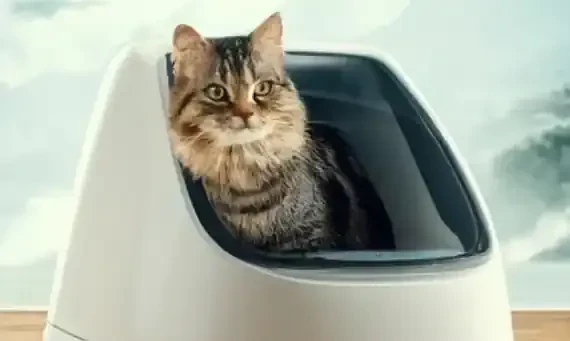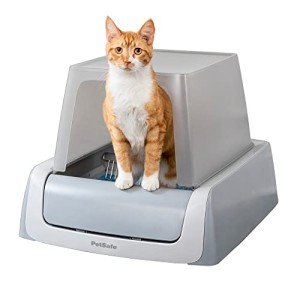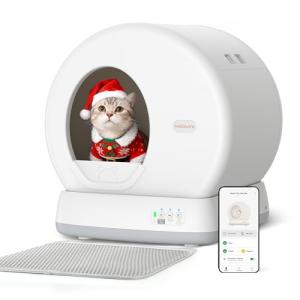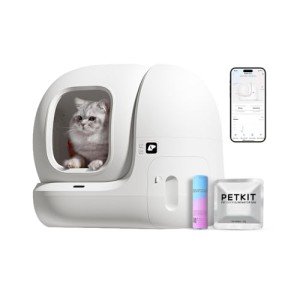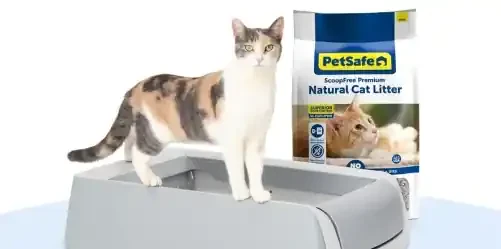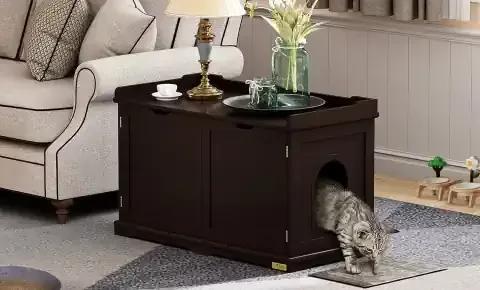Introduction
A soft purr reverberates through the room as your feline companion saunters over, rubbing affectionately against your legs. There's an undeniable warmth that comes with sharing your home with a cat – the playful antics, the soothing presence, the unwavering companionship. Yet, nestled within this bundle of joy lies a less enchanting aspect of pet ownership: the inevitable chore of tending to the litter box.
For cat owners, the ritual of scooping, sifting, and disposing of litter is a familiar, if not somewhat dreaded, routine. The pungent aroma, the scattered mess, the persistent need for vigilance – these are the less glamorous facets of feline companionship that many endure in the name of love. But what if there was a way to alleviate the burden of litter box maintenance while enhancing the overall well-being of both pet and owner?
Enter the automatic cat litter box – a marvel of modern pet care technology poised to revolutionize the way we manage our feline friends' waste. Gone are the days of manual scooping and laborious cleaning sessions. In their place, a new era of convenience and efficiency beckons, promising to streamline the litter box experience for cat lovers worldwide.
The Promise of Automation
Imagine a world where the chore of litter box maintenance becomes a relic of the past – where cat owners are liberated from the mundane tasks of scooping and disposing, free to focus on the joys of pet companionship without the lingering specter of unpleasant odors and unsightly messes. This is the promise of the automatic cat litter box – a promise rooted in the relentless pursuit of innovation and the desire to enhance the lives of both pets and their devoted caretakers.
At its core, the automatic cat litter box represents a convergence of cutting-edge technology and unwavering dedication to pet welfare. It embodies the notion that pet care should be as seamless and stress-free as possible, freeing up valuable time and energy to be spent on more meaningful interactions with our beloved furry friends.
Overview of the Article
In this comprehensive guide, we embark on a journey into the world of automatic cat litter boxes – exploring their inner workings, extolling their myriad benefits, and offering practical insights to help prospective pet owners navigate the landscape of litter box technology with confidence and clarity.
We'll begin by delving into the fundamental concepts behind automatic cat litter boxes, unraveling the mysteries of their design and functionality. From there, we'll explore the myriad benefits these innovative devices offer, from time-saving convenience to enhanced odor control and improved cat health.
Next, we'll take a closer look at the various types of automatic cat litter boxes available on the market today, offering insights into their unique features and suitability for different household setups. We'll also discuss important considerations to keep in mind before making a purchase, including cost analysis, space requirements, and compatibility with your cat's behavior.
But our journey doesn't end there. We'll also delve into the nitty-gritty of maintenance and care, offering practical tips for keeping your automatic litter box in peak condition for years to come. Along the way, we'll share real-world user experiences and expert recommendations to help you make informed decisions about which automatic litter box is right for you and your feline companion.
Finally, we'll cast our gaze toward the horizon, exploring future trends and innovations in automatic litter box technology. From advancements in smart home integration to sustainable solutions aimed at reducing environmental impact, the future of pet care is brimming with possibility – and the automatic cat litter box is leading the charge.
Join us as we embark on this fascinating journey into the world of automatic cat litter boxes – where convenience meets compassion, and the bond between pet and owner grows stronger with each automated scoop.
Understanding Automatic Cat Litter Boxes
In the quest to revolutionize pet care, understanding the inner workings of automatic cat litter boxes is paramount. These ingenious devices represent the culmination of years of innovation and engineering, designed to simplify the task of litter box maintenance while providing a cleaner, healthier environment for both cats and their human companions.
Definition and Functionality
So, what exactly are automatic cat litter boxes, and how do they work? At their core, automatic litter boxes are self-contained units equipped with sensors, scooping mechanisms, and waste disposal systems that automate the process of cleaning and maintaining the litter box.
Unlike traditional litter boxes, which rely on manual scooping and cleaning, automatic litter boxes employ a variety of mechanisms to detect when a cat has used the box and remove waste accordingly. This can range from simple timers that activate the cleaning mechanism at regular intervals to sophisticated sensors that detect the presence of a cat and initiate the cleaning process automatically.
Once activated, the cleaning mechanism typically consists of a rake or conveyor system that sifts through the litter, separating waste from clean litter and depositing it into a removable tray or receptacle for easy disposal. Some automatic litter boxes even offer additional features such as odor control systems, self-cleaning mechanisms, and programmable settings to customize the cleaning cycle to suit your cat's needs.
Evolution of Cat Litter Technology
The concept of automatic litter boxes may seem like a relatively recent innovation, but the truth is that the evolution of cat litter technology spans several decades. In the early days of cat ownership, litter boxes were little more than basic trays filled with sand or soil, requiring manual scooping and cleaning by the pet owner.
As pet ownership became more widespread and technology advanced, so too did the evolution of cat litter boxes. In the 1950s, the introduction of clumping litter revolutionized the way cats' waste was managed, making it easier to scoop and dispose of soiled litter. This innovation laid the groundwork for the development of more sophisticated litter box designs in the decades to come.
By the 1990s, the first generation of automatic litter boxes began to emerge, offering pet owners a glimpse of a future where litter box maintenance was a thing of the past. These early models were rudimentary by today's standards, often prone to mechanical failures and limited in their ability to effectively remove waste from the litter box.
However, as technology continued to advance, so too did the capabilities of automatic litter boxes. Today, modern automatic litter boxes are equipped with state-of-the-art sensors, motors, and control systems that allow for precise and efficient waste removal, providing a level of convenience and hygiene that was once unimaginable.
How Do They Work?
At the heart of every automatic litter box lies a sophisticated array of sensors, motors, and control systems that work in concert to detect when a cat has used the box and initiate the cleaning process. These sensors can detect the weight of the cat, the presence of waste, or even the sound of a cat digging in the litter, triggering the cleaning mechanism to spring into action.
Once activated, the cleaning mechanism typically consists of a rake or conveyor system that moves through the litter, scooping up waste and depositing it into a separate compartment for disposal. Some automatic litter boxes use rotating drums or sifters to separate waste from clean litter, while others employ more advanced mechanisms such as air filtration systems or UV sterilization to eliminate odors and bacteria.
The cleaning cycle can be customized to suit your cat's needs, with options to adjust the frequency and duration of the cleaning cycle to accommodate multiple cats or specific litter preferences. Some automatic litter boxes even offer programmable settings that allow you to schedule cleaning cycles in advance, ensuring that your cat's litter box is always clean and ready for use.
In the next part of our guide, we'll explore the myriad benefits of automatic cat litter boxes, from time-saving convenience to improved odor control and cat health. Join us as we continue our journey into the world of automatic pet care technology, where the future of feline companionship is brighter and cleaner than ever before.
Benefits of Automatic Cat Litter Boxes
As we delve deeper into the realm of automatic cat litter boxes, it becomes increasingly clear that these innovative devices offer far more than just convenience. From saving time and effort to improving overall hygiene, the benefits of automatic litter boxes are manifold, promising to enhance the lives of both pets and their owners in ways previously unimaginable.
Time-Saving Convenience
Perhaps the most immediate and tangible benefit of automatic cat litter boxes is the time-saving convenience they afford to pet owners. No longer relegated to the daily chore of scooping and cleaning, cat owners can reclaim precious minutes – even hours – of their day, allowing them to focus on more meaningful interactions with their feline companions.
With automatic litter boxes, the need for manual intervention is virtually eliminated, replaced by a seamless and efficient cleaning process that requires little to no effort on the part of the owner. Whether you're a busy professional juggling work and family responsibilities or simply someone who values their free time, the time-saving convenience of automatic litter boxes is sure to be a game-changer.
Improved Odor Control
One of the perennial challenges of cat ownership is managing litter box odors, which can quickly permeate a home and detract from the overall living experience. Traditional litter boxes, with their open design and manual scooping requirements, often struggle to contain odors effectively, leaving pet owners scrambling for solutions to mask or eliminate unpleasant smells.
Enter the automatic cat litter box, with its advanced odor control systems and self-cleaning mechanisms designed to keep foul odors at bay. By promptly removing waste from the litter box and sealing it in a separate compartment, automatic litter boxes help to minimize odor buildup, creating a cleaner and more pleasant environment for both cats and humans alike.
Improved Cat Health
Beyond the realm of convenience and odor control, automatic cat litter boxes also offer tangible benefits for the health and well-being of our feline friends. By providing a consistently clean and hygienic litter box environment, automatic litter boxes help to reduce the risk of urinary tract infections, bacterial overgrowth, and other health issues commonly associated with poor litter box hygiene.
Moreover, some automatic litter boxes are equipped with features such as UV sterilization or antimicrobial coatings, which further enhance their ability to maintain a sanitary environment free from harmful bacteria and pathogens. This not only promotes better health for your cat but also provides peace of mind for pet owners concerned about their furry companion's well-being.
In the next part of our guide, we'll explore the various types of automatic cat litter boxes available on the market today, from self-cleaning models to flushable options and multi-cat systems. Join us as we continue our journey into the world of automatic pet care technology, where convenience meets compassion and the bond between pet and owner grows stronger with each automated scoop.
Types of Automatic Cat Litter Boxes
As the demand for automatic cat litter boxes continues to grow, so too does the variety of options available to pet owners seeking to simplify the task of litter box maintenance. From self-cleaning models to flushable options and multi-cat systems, the world of automatic litter boxes is brimming with innovation and versatility, catering to the diverse needs and preferences of cat owners everywhere.
Self-Cleaning Models
Among the most popular and widely available types of automatic cat litter boxes are self-cleaning models, which utilize sensors and motorized mechanisms to remove waste from the litter box automatically. These devices typically feature a rake or conveyor system that sifts through the litter, separating clumps of waste from clean litter and depositing them into a removable tray or receptacle for easy disposal.
Self-cleaning litter boxes come in a variety of designs and configurations, with options ranging from basic models that perform a single cleaning cycle after each use to more sophisticated models that offer programmable settings and customizable cleaning cycles. Some self-cleaning litter boxes even feature built-in sensors that detect when a cat has used the box and initiate the cleaning process automatically, ensuring that the litter box remains clean and ready for use at all times.
Flushable Litter Boxes
For pet owners seeking a more eco-friendly solution to litter box maintenance, flushable litter boxes offer a convenient and environmentally conscious alternative to traditional disposal methods. These innovative devices are designed to be used with biodegradable litter that can be safely flushed down the toilet, eliminating the need for manual scooping and reducing the amount of waste that ends up in landfills.
Flushable litter boxes typically feature a special design that allows solid waste to be separated from liquid waste, making it easier to dispose of both components separately. Some models even come equipped with built-in plumbing connections that allow waste to be flushed directly into the sewer system, eliminating the need for manual handling altogether.
Multi-Cat Systems
For households with multiple cats, traditional litter boxes can quickly become overwhelmed, leading to messy and unsanitary conditions that are unpleasant for both pets and their owners. Fortunately, there are automatic litter boxes specifically designed to accommodate the needs of multi-cat households, offering larger capacities and enhanced cleaning capabilities to keep up with the demands of multiple feline occupants.
Multi-cat litter boxes come in a variety of configurations, with options ranging from spacious open-top designs to enclosed units with multiple compartments for separate waste collection. These devices often feature advanced sensors and motorized mechanisms that can detect and remove waste from multiple cats simultaneously, ensuring that the litter box remains clean and sanitary even in the busiest of households.
In the next part of our guide, we'll explore important considerations to keep in mind before purchasing an automatic cat litter box, including cost analysis, space requirements, and compatibility with your cat's behavior. Join us as we continue our journey into the world of automatic pet care technology, where convenience meets compassion and the bond between pet and owner grows stronger with each automated scoop.
Considerations Before Purchasing
Before delving into the world of automatic cat litter boxes, it's essential to consider a few key factors to ensure you choose the right option for both you and your feline companion. From cost analysis to space requirements and compatibility with your cat's behavior, taking the time to weigh these considerations can help you make an informed decision and set the stage for a successful transition to automatic litter box maintenance.
Cost Analysis
One of the first considerations when exploring automatic cat litter boxes is the upfront cost versus the long-term savings in time and effort. While automatic litter boxes may represent a significant initial investment compared to traditional litter boxes, many pet owners find that the convenience and efficiency they offer more than justify the expense over time.
When evaluating the cost of automatic litter boxes, consider not only the purchase price of the device itself but also any ongoing expenses such as replacement parts, consumables like litter cartridges or waste receptacles, and potential maintenance or repair costs. Additionally, factor in the potential savings in terms of time and energy saved from no longer needing to manually scoop and clean the litter box on a daily basis.
Space Requirements
Another important consideration when choosing an automatic cat litter box is the amount of space available in your home. Automatic litter boxes come in a variety of sizes and configurations, ranging from compact units suitable for small apartments to larger models designed to accommodate multiple cats or larger breeds.
Before making a purchase, take measurements of the space where you plan to place the litter box and ensure that the dimensions of the device are compatible with your available space. Consider factors such as clearance for the cleaning mechanism to operate effectively, as well as access to power outlets for devices that require electricity to function.
Compatibility with Cat Behavior
Perhaps the most critical consideration when selecting an automatic cat litter box is its compatibility with your cat's behavior and preferences. While some cats adapt easily to automatic litter boxes, others may be more resistant to change, requiring time and patience to acclimate to the new system.
Before making a purchase, consider factors such as your cat's age, size, and temperament, as well as any specific litter preferences or aversions they may have. Introduce your cat to the automatic litter box gradually, providing positive reinforcement and encouragement to help them feel comfortable using the new device.
Additionally, consider whether your cat's behavior is likely to trigger false activations of the cleaning mechanism, such as digging or scratching in the litter box. Look for automatic litter boxes with adjustable settings or sensitivity controls that allow you to customize the cleaning cycle to suit your cat's behavior and minimize disruptions.
By carefully weighing these considerations before purchasing an automatic cat litter box, you can ensure that you choose a device that meets both your needs and the needs of your feline companion. In the next part of our guide, we'll explore maintenance and care tips to help keep your automatic litter box running smoothly for years to come. Join us as we continue our journey into the world of automatic pet care technology, where convenience meets compassion and the bond between pet and owner grows stronger with each automated scoop.
Maintenance and Care
Maintaining an automatic cat litter box is essential to ensure its optimal performance and longevity. While these innovative devices streamline the process of litter box maintenance, they still require regular care and attention to keep them running smoothly and effectively. In this part of our guide, we'll explore the essential maintenance tasks and care tips to help you keep your automatic litter box in peak condition.
Cleaning and Refilling
Regular cleaning and refilling are crucial to keeping your automatic litter box functioning properly. Depending on the model you choose, you may need to empty the waste receptacle, replace litter cartridges, or clean the interior of the litter box on a regular basis. Follow the manufacturer's instructions for cleaning and maintenance, and be sure to use only recommended cleaning products and litter types to avoid damaging the device.
When cleaning the litter box, be sure to disconnect it from power sources and remove any removable parts or components, such as waste receptacles or litter trays. Clean these components thoroughly with mild soap and water, and allow them to dry completely before reassembling the litter box. Check for any signs of wear or damage, such as frayed cords or broken parts, and replace them as needed to ensure safe and effective operation.
Troubleshooting Common Issues
Like any electronic device, automatic cat litter boxes may experience occasional issues or malfunctions that require troubleshooting. Common problems include sensor errors, motor failures, and mechanical jams, which can disrupt the cleaning cycle and prevent the litter box from functioning properly. If you encounter any issues with your automatic litter box, consult the manufacturer's troubleshooting guide for instructions on how to resolve them.
In some cases, simple fixes such as cleaning sensors or removing obstructions from the cleaning mechanism may solve the problem. However, if the issue persists or if you're unsure how to address it, contact the manufacturer's customer support for assistance. Avoid attempting to repair or modify the litter box yourself, as this may void the warranty or cause further damage to the device.
Longevity and Durability
To ensure the longevity and durability of your automatic cat litter box, it's essential to follow proper maintenance and care practices. Avoid overfilling the litter box or exceeding its recommended weight capacity, as this can strain the motor and cause premature wear and tear. Additionally, place the litter box in a stable and secure location away from sources of moisture or extreme temperatures to prevent damage to electronic components.
Regularly inspect the litter box for signs of wear or damage, such as loose screws, cracked casings, or frayed cords, and address any issues promptly to prevent further damage. Consider investing in a quality litter box cover or mat to protect the surrounding area from litter scatter and spills, and clean the area around the litter box regularly to maintain a clean and hygienic environment for your cat.
By following these maintenance and care tips, you can ensure that your automatic cat litter box remains clean, efficient, and reliable for years to come. In the next part of our guide, we'll explore user experiences and reviews to provide insights into the real-world performance of automatic litter boxes. Join us as we continue our journey into the world of automatic pet care technology, where convenience meets compassion and the bond between pet and owner grows stronger with each automated scoop.
User Experiences and Reviews
Real-world user experiences and reviews offer invaluable insights into the performance and efficacy of automatic cat litter boxes. By hearing from pet owners who have integrated these innovative devices into their homes, prospective buyers can gain valuable perspectives and make more informed decisions about which automatic litter box is right for them and their furry companions. In this part of our guide, we'll explore user experiences and reviews to provide insights into the advantages and limitations of automatic litter boxes.
Consumer Feedback
One of the most valuable sources of information about automatic cat litter boxes is feedback from fellow pet owners who have firsthand experience with these devices. Online forums, social media groups, and product review websites are excellent resources for finding user reviews and testimonials from individuals who have used automatic litter boxes in their homes.
Pay attention to common themes and patterns in user feedback, such as reliability, ease of use, and effectiveness at controlling odors. Look for reviews from pet owners with similar household setups and cat personalities to get a sense of how well the litter box is likely to perform in your own home.
Pros and Cons
As you read through user experiences and reviews, it's important to consider both the pros and cons of automatic cat litter boxes. While many pet owners praise the convenience and efficiency of these devices, others may encounter issues or limitations that impact their overall satisfaction.
Pros of automatic litter boxes may include:
Time-saving convenience: Many users appreciate the ability to automate the litter box cleaning process, freeing up time and energy for other tasks.
Improved odor control: Automatic litter boxes often feature advanced odor control systems that help keep unpleasant smells at bay.
Enhanced cat health: By maintaining a cleaner and more hygienic litter box environment, automatic litter boxes can help promote better health for cats.
Cons of automatic litter boxes may include:
Initial cost: Automatic litter boxes can be more expensive upfront compared to traditional litter boxes, which may deter some pet owners.
Maintenance requirements: While automatic litter boxes streamline the cleaning process, they still require regular maintenance and care to ensure optimal performance.
Compatibility issues: Some cats may be resistant to using automatic litter boxes or may trigger false activations of the cleaning mechanism, leading to disruptions in the cleaning cycle.
Expert Recommendations
In addition to user experiences and reviews, consider seeking out expert recommendations from veterinarians or pet care professionals. These individuals can offer valuable insights into the suitability of automatic litter boxes for different household setups and provide guidance on selecting the right device for your specific needs.
By combining user experiences and reviews with expert recommendations, you can gain a comprehensive understanding of the advantages and limitations of automatic cat litter boxes and make a more informed decision about which device is right for you and your furry companion. In the next part of our guide, we'll explore future trends and innovations in automatic litter box technology, offering a glimpse into the exciting possibilities that lie ahead. Join us as we continue our journey into the world of automatic pet care technology, where convenience meets compassion and the bond between pet and owner grows stronger with each automated scoop.
Future Trends and Innovations
The landscape of automatic cat litter boxes is constantly evolving, driven by advances in technology, changing consumer preferences, and a growing emphasis on sustainability and environmental responsibility. As we look to the future, a host of exciting trends and innovations promise to further revolutionize the way we care for our feline companions. In this part of our guide, we'll explore some of the emerging trends and innovations shaping the future of automatic litter box technology.
Advancements in Technology
One of the most significant trends driving the future of automatic cat litter boxes is the continued advancement of technology. As sensor technology, robotics, and artificial intelligence continue to improve, we can expect to see increasingly sophisticated litter box designs that offer enhanced performance, reliability, and customization options.
Future automatic litter boxes may feature advanced sensors capable of detecting subtle changes in a cat's behavior or health, allowing for more precise and proactive management of litter box maintenance. Similarly, advancements in robotics may enable more efficient and thorough cleaning mechanisms, reducing the risk of clogs, jams, and other mechanical issues.
Integration with Smart Home Systems
Another emerging trend in automatic litter box technology is integration with smart home systems. As smart home technology becomes increasingly prevalent in modern households, pet owners are seeking ways to seamlessly integrate their automatic litter boxes into their connected home ecosystems.
Future automatic litter boxes may feature built-in Wi-Fi connectivity and compatibility with popular smart home platforms, allowing pet owners to monitor and control their litter box remotely via smartphone apps or voice-activated assistants. This level of connectivity opens up a host of possibilities, from receiving real-time alerts when the litter box needs attention to tracking usage patterns and monitoring the health and well-being of your cat.
Sustainable Solutions
In an era of increasing environmental awareness, sustainability has become a key consideration for pet owners seeking eco-friendly solutions to litter box maintenance. Future automatic litter boxes may incorporate sustainable materials and manufacturing processes, as well as innovative waste disposal methods aimed at reducing environmental impact.
Some manufacturers are already exploring biodegradable litter options that can be safely composted or disposed of in an environmentally responsible manner, minimizing the amount of waste that ends up in landfills. Additionally, flushable litter boxes may become more widespread, offering a convenient and eco-friendly alternative to traditional disposal methods.
Automatic Cat Litter Box
As we look to the future of automatic cat litter boxes, the possibilities are endless. From advancements in technology and integration with smart home systems to a growing emphasis on sustainability and environmental responsibility, the future of automatic litter box technology is bright and full of promise.
By staying informed about emerging trends and innovations, pet owners can make informed decisions about which automatic litter box is right for their needs and preferences. Whether you're looking for convenience, reliability, or sustainability, the future of automatic litter box technology has something for everyone.
In concluding our guide, we invite you to embrace the exciting possibilities that lie ahead and join us in shaping the future of pet care technology. Together, we can create a world where caring for our furry companions is easier, more efficient, and more sustainable than ever before.
